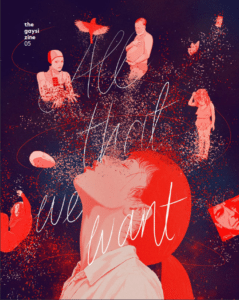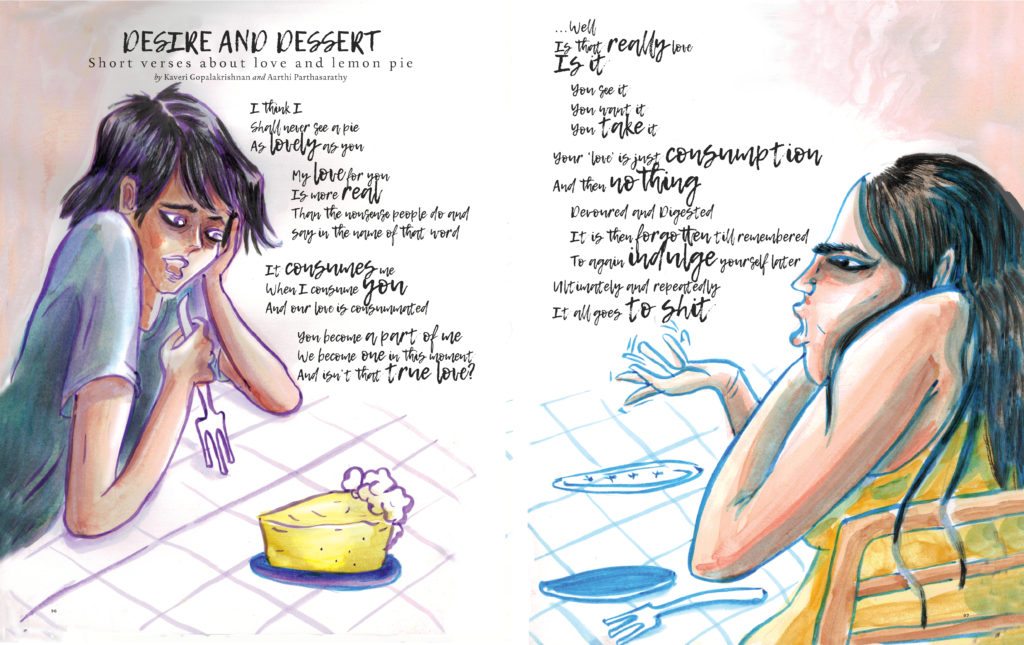The Gaysi Zine Vol 5: All That We Want
Editors: Indu Jain and Priya Gangwani
Contributors: Aarthi Parthasarathy, Abeer Hoque, Abhishek Chaudhary, Aindri Chakraborty, Akhila Krishnan, Akshay Mahajan, Alaric Moras, Anar-e Sistanem, Balbir Krishan, Benjamin Zachariah, Brian Horton, Dhrubo Jyoti, Jaya Sharma, Kaveri Gopalakrishnan, Kiran Rajagopalan, M.G. Ashley, Michael Giangrasso, Minal Hajratwala, Mira Malhotra, Parvati Sharma, Rosalyn D’Mello, Sig Monty, Soumitro Datta, Tanya Daniel Eden, The Kinky Collective, and Karishma Dorai
Last year I reviewed volume 4 of The Gaysi Zine, a publication produced by the India-based Gaysi family who work to connect queer and trans Desis all over the world. When the team announced volume five’s publication in January I was immediately drawn in by the concept: desire. Volume five, titled All That We Want, promises to “speak of the collective conscience of the Indian queer people and brings to you narratives of desire often not spoken about or even acknowledged in the mainstream consciousness,” and delivers beautifully on that promise. Gaysi graciously sent me a review copy of the zine and I’m genuinely ashamed it’s taken me so long to tell you all about it, because I want it in all your queer hands immediately.
 All That We Want is an impressive zine simply to hold and flip through. The cover design and interior layout are warm, sensual, and incredibly inviting. Karishma Dorai’s cover – on which red and pink spacklings of color drift among figures of varying ages and genders – hints that the topics inside will focus on connection. Black and white title pages, sprinklings of red text, and interjections of parchment colored backgrounds, which immediately evoke the concept of intimate letter-writing, all carry this feeling of connection throughout the zine. I’ve never held a piece of art in my hands that felt so whole.
All That We Want is an impressive zine simply to hold and flip through. The cover design and interior layout are warm, sensual, and incredibly inviting. Karishma Dorai’s cover – on which red and pink spacklings of color drift among figures of varying ages and genders – hints that the topics inside will focus on connection. Black and white title pages, sprinklings of red text, and interjections of parchment colored backgrounds, which immediately evoke the concept of intimate letter-writing, all carry this feeling of connection throughout the zine. I’ve never held a piece of art in my hands that felt so whole.
In the introduction to All That We Want, curators Priya Gangwani and Karishma Dorai explain why they chose “desire” for the fifth volume’s theme. Initially they worried that the concept was too vague, but ultimately were drawn to it because, “sometimes, our desire seeks sanctuary in others; exploring the unfathomable difficulties of opening up to someone when busy fighting our own fears, and confronting our own judgments. Other times, it helps us navigate a more honest quality of life, forcing us to face what we suppress.”
All That We Want is split into three sections and works through these concepts in reverse, beginning with “The Looking Glass,” a title that correctly implies the stories within will examine internal, sometimes suppressed desire. Perhaps the most obvious manifestation of this idea is Akshay Mahajan’s photo essay “I Belong Deeply to Myself,” which Mahajan claims contains pure images of the self, able to explore desire without “the social norms and occupation of gender.” The subjects of Mahajan’s photographs pose in their homes, in abandoned places, and in empty spaces. They all seem to exist in sanctuaries that are built not just by walls, but by sunlight, friends, partners, pets, makeup, clothes, plants–a number of settings and objects that all create safety.

Other pieces in “The Looking Glass” remind the reader that desire is not always easy and not always safe. Dhrubo Jyoti’s essay, “Never Lost,” positions easy access to desire as a privilege held by people who lack marginalized identities. For Jyoti, who is fat, lower caste, genderqueer, and queer, desire is not experienced so easily. In “Cities of the Interior,” Rosalyn D’Mello elevates masturbation to art in a manner that reminded me of the sex scenes in Allison Bechdel’s Fun Home. Sexual acts long stigmatized are juxtaposed with literature and, when celebrated, allow the practitioners to be free from shame. Each of the writers, illustrators and photographers published in this first section work to celebrate queer desire, and their struggles all yield satisfying results.
“The Interstice,” All That We Want’s second section, most directly addresses the idea of intimate connection. Merriam-Webster defines “interstice” as “a space that intervenes between things, especially between closely spaced things.” Appropriately, this section opens with “The Hourglass,” a short story by Abeer Y. Hoque about exploring one’s identity through the power dynamics of sex. The narrator tracks the growth of desire in her body over time, through years of longing and suppression – because, of course, two women are not supposed to experience desire together – but eventually is able to experience desire as a give-and-take between two people. Abhishek Chaudhary echoes this sense of queer, mischievous, hidden desire in his photo essay “A Homely Girl,” which parades that desire freely within the sanctuary of home. Here, the connection is not between two people but rather between an individual and the fully open, honest self that they can be within a safe space.
As “The Interstice” nears its end, Alaric Moras pulls the reader away from satisfying desire with “In Times of Trouble,” which explores an almost sexually intimate relationship between a straight woman and a gay man. Rather than lacking connection, the pair connect in abundance, but there is still a gap between them that cannot be closed. Akhila Krishnan similarly reflects on lack of connection – or, more specifically, loneliness – as an intimate space in comic form. Appropriately, “Alone but not lonely: Most of the time” is one of several comics that appear in the zine as a result of a collaboration between Gaysi and Kadak, a collective of South Asian women who are graphic storytellers. Krishnan interviewed several single women to create a cohesive comic presented first solely with images and then with the text, pressing the reader to question what the context-less images make them assume about the interviewees. The images focus heavily on objects that make up a daily routine–cell phones, dirty laundry, laptops, and mirrors–and each image makes an empty, supposedly lonely space feel deeply intimate.

The zine’s final section, “The Clearing,” feels like a dive into potentially uncharted territory. Tanya Eden and Karishma Dorai’s guide to scissoring, for example, gives suggestions to those looking to try something new, while Jaya Sharma’s poem “Touching Taboos” seeks to describe the power released by engaging in taboo behavior. However, my favorite piece in this section is the first: “One Thing in Three Pieces,” by Soumitro Datta. Datta’s three poems described, to me, three things in a specific order: new desire freshly given, desire as exactly what you wanted, and desire as what you want, but did not expect. I loved this piece for the way it tracks desire as a shifting, sometimes unpredictable experience. The last poem in particular, “The Illustrated Man,” draws the reader back to the Neil Gaiman quotation that appears at the beginning of the zine: “All of the people in the whole world… inside them, they’ve all got unimaginable, magnificent, wonderful, stupid, amazing worlds…” How beautiful it is to feel a desire for someone that grows as you discover their endless worlds!
The poems, photographs, comics, and stories described here are just a sampling of the incredible work published in All That We Want. I want each queer and trans person who has ever felt burdened by the nature of their desire to hold this zine in their hands. Buy a copy for yourself, your friends, your lovers, anyone you’re comfortable gifting a very beautiful, very NSFW zine about queer desire. Purchasing instructions for both Indian and international readers are available here, as are past volumes of the zine. Don’t be a chump like me! Order it ASAP.

